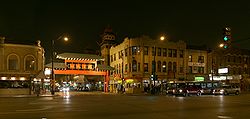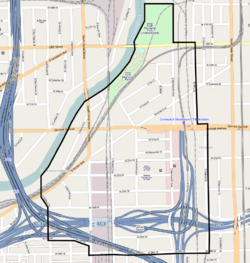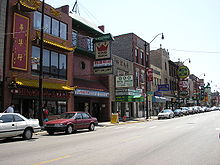- Chinatown, Chicago
-
Coordinates: 41°51′10″N 87°37′55″W / 41.852861°N 87.631894°W
Chinatown, Chicago — Neighborhood — Cermak Avenue including the Chinatown Gate over Wentworth Avenue Map of Chinatown Country United States City Chicago Community area Armour Square First settled 1912 Population [1] - Estimate (2009) 8,000 ZIP code 60616 The Chinatown neighborhood in Chicago, Illinois, is on the South Side (located in the Armour Square community area), centered on Cermak and Wentworth Avenues, and is an example of an American Chinatown, or ethnic-Chinese neighborhood. By the 2000 Census, Chicago Primary Metropolitan Statistical Areas has 68,021 Chinese. Chicago is the second oldest settlement of Chinese in America after the Chinese fled persecution in California.
It is not to be confused with an area sometimes called "New Chinatown", which is on the North Side around Argyle Street, and which attracts a larger number of people of Southeast Asian heritage.
Contents
History
Looking to escape the anti-Chinese violence that had broken out on the west coast, the first Chinese arrived in Chicago after 1869 when the First Transcontinental Railroad was completed.[2] By the late 1800s, 25% of Chicago's approximately 600 Chinese residents settled along Clark Street between Van Buren and Harrison Avenues in Chicago's Loop.[3] In 1889, 16 Chinese-owned businesses were located along the two-block stretch, including eight grocery stores, two butcher shops and a restaurant.[4] Faced with increasing rent prices, the Chinese living in this area began moving south to Armour Square in 1912.[3][5] This exodus was led by the On Leong Merchants Association who, in 1912, had a building constructed along Cermak Avenue (then 22nd Street) that could house 15 stores, 30 apartments and the Association's headquarters. While the building's design was typical of the period, it also featured Chinese accents such as tile trim adorned with dragons.[6]
In the 1920s, Chinese community leaders secured approximately 50 ten-year leases on properties in the newly developing Chinatown.[7] Because of severe racial discrimination, these leases needed to be secured via an intermediary, H. O. Stone Company.[5] Jim Moy, then-director of the On Leong Merchants Association, then decided that a Chinese-style building should be constructed as a strong visual announcement of the Chinese community's new presence in the area.[7][8] With no Chinese-born architects in Chicago at the time, Chicago-born Norse architects Christian S. Michaelsen and Sigurd A. Rognstad were asked to design the new On Leong Merchants Association Building in spring, 1926.[9] After studying texts on Chinese architecture,[7] Michaelsen and Rognstad's final design was an example of Orientalism, a Western architect's interpretation of Chinese architectural forms.[10] When the building opened in 1928, the On Leong Association used it as an immigrant assistance center that housed various meeting halls, a school, a shrine and the Association's offices,[11][12] It was often informally referred to as Chinatown's "city hall."[7] Michaelsen and Rognstad designed two other Chinese-inspired buildings that were built in the area in 1928—Won Kow Restaurant, Chinatown's oldest restaurant,[13] and the Moy Shee D.K Association Building, the former receiving a two-story addition in 1932.[14]
During the late 1980s, a group of Chinatown business leaders bought 32 acres (130,000 m2) property north of Archer Avenue from the Santa Fe Railway and built Chinatown Square, a two-level mall consisting of restaurants, beauty salons and law offices, flanked by 21 new townhouses. Additional residential construction, such as the Santa Fe Gardens, a 600-unit village of townhouses, condominiums and single-family homes still under construction on formerly industrial land to the north.[15]
Commerce
Chinatown, Chicago 
Wentworth Avenue Traditional Chinese 芝加哥華埠 Simplified Chinese 芝加哥华埠 Transcriptions Mandarin - Hanyu Pinyin Zhījiāgē Huá Bù - Tongyong Pinyin Jhihjiage Húa Bú - Wade–Giles Chih1chia1ke1 Hua2 Pu4 - IPA [tʂɨ́tɕjákɤ́ xwǎ pʰŷ] - Gwoyeu Romatzyh Jyjiage Hwabuh Min - Hokkien POJ Chi-cha-ko Hôa-bú Cantonese (Yue) - Jyutping Zi1gaa1go1 Waa4 Bou6 - IPA /tɕiː˥˧gaː˥˧kɔː˥˧.waː.˩bou˨/ - Yale Romanization Jrjyake Hwabu Chicago's Chinatown is home to a number of banks, Chinese restaurants, gift shops, grocery stores, Chinese medicine stores, as well as a number of services that cater to people interested in Chinese culture, including those speaking Chinese, especially the Cantonese dialect. It is a community hub for Chinese people in Chicago metropolitan area, a business center for Chinese in the Midwest, as well as a popular destination for tourists and locals alike.
Landmarks and attractions
- Chinatown Mural, a mural showing the history of Chinese immigrants in United States
- Chinatown Square, with sculptures of animals in the Chinese zodiac
- Wentworth Avenue, with shopping, restaurants, and landmarks, including the Chinatown Gate
- Pui Tak Center was designated a Chicago Landmark on December 1, 1993. It was the On Leong Merchants Association Building.
- Chinese-American Museum of Chicago, conducts research and exhibits objects and pictures relating to the history of Chinese in the American Midwest. The museum experienced a fire on September 19, 2008 and was temporarily closed. Thanks to strong community support, it reopened in the fall of 2010 with improved facilities.
- Ping Tom Memorial Park, with Chinese gardens along the Chicago River
The Chinese-American Museum of Chicago has a a list of historic places.
- Chicago Fire Department Engine 8 Company firehouse, firehouse used in the 1991 Ron Howard film Backdraft
Government and infrastructure
The United States Postal Service operates the Chinatown Post Office at 2345 South Wentworth Avenue.[16]
Education
Primary and secondary schools
Residents are zoned to schools in the Chicago Public Schools including John C. Haines School and Phillips Academy High School.[17][18]
The Roman Catholic Archdiocese of Chicago supports the St. Therese Chinese Catholic School, a K-8 private Catholic school.[19]
The Pui Tak Christian School, a private pre-kindergarten to 6th grade school.[20]
Public libraries
The Chicago Public Library operates the Chinatown Library at 2353 South Wentworth Avenue.[21]
Transportation
The Dan Ryan Expressway and the Stevenson Expressway intersect over the southside of Chinatown. The Stevenson's exit 293A (northbound exit and southbound entrances) gives Chinatown commuters immediate access to the expressways via Cermak Road, only one block east of Wentworth Avenue. There is metered street parking throughout the area, as well as two pay parking lots located on Wentworth Avenue.[22]
Several forms of public transportation are also available in Chinatown. The Chicago Transit Authority operates both an elevated train and four bus routes that service the area. The north–south-running Red Line, the CTA's busiest transit route, stops regularly at the Cermak–Chinatown station located in the heart of Chinatown near the corner of Cermak Road and Wentworth Avenue.[23][24] Running north–south, the #24 bus route runs on Wentworth Avenue on the eastside of Chinatown, while the #44 route runs on Canal Street on the westside. The #21 runs east–west on Cermak Road, and the #62 runs diagonally southwest–northeast on Archer Avenue.[25] There is a taxicab stand on Wentworth Avenue, and a water taxi service also runs along the Chicago River from Michigan Avenue to Ping Tom Memorial Park in Chinatown during the summer months.[1]
Annual events
References
- ^ a b Laffey, Mary Lu (2009-06-26). "Chinatown: A 'hidden jewel' worth seeking". Chicago Tribune. http://www.chicagotribune.com/classified/realestate/chi-chinatown-profile_chomes_062jun26,0,4689003.story. Retrieved 2009-08-11.
- ^ Ho 2005, p. 9.
- ^ a b Kiang 2008
- ^ Malooley, Jake (April 29, 2010). "It happened here - Chicago's original Chinatown". Time Out Chicago (Time Out Chicago Partners) (270): 6.
- ^ a b Solzman 2008
- ^ "Earliest South Side Chinatown: A Forgotten On Leong Building, ca. 1912". Chinese-American Museum of Chicago. July 14, 2005. http://www.ccamuseum.org/Places.html#anchor_33. Retrieved October 7, 2009.
- ^ a b c d Leroux, Charles (January 6, 2002). "Still Standing - Living links to a rich history of commerce and culture". Chicago Tribune. Newsbank. http://docs.newsbank.com/openurl?ctx_ver=z39.88-2004&rft_id=info:sid/iw.newsbank.com:NewsBank:CTRB&rft_val_format=info:ofi/fmt:kev:mtx:ctx&rft_dat=0F0E0E5495527971&svc_dat=InfoWeb:aggregated5&req_dat=AA98CDC331574F0ABEAFF732B33DC0B2. Retrieved August 10, 2009.
- ^ Ho 2005, p. 58.
- ^ "Our Building". Chinese Christian Union Church. http://www.puitak.org/building.php. Retrieved February 9, 2009.[dead link]
- ^ "Pui Tak Building (formerly On Leong Building), 2216 S Wentworth Avenue". Chinese-American Museum of Chicago. August 7, 2005. http://www.ccamuseum.org/Places.html#anchor_10. Retrieved February 9, 2009.
- ^ Herrmann, Andrew (November 17, 1995). "Chinese Church Gives Landmark A Rebuilt Image". Chicago Sun-Times. Newsbank. http://infoweb.newsbank.com/iw-search/we/InfoWeb?p_product=NewsBank&p_theme=aggregated5&p_action=doc&p_docid=0EB4227194CEDE69&p_docnum=9&p_queryname=25. Retrieved February 9, 2009.
- ^ "On Leong Merchants Association Building". City of Chicago Department of Planning and Development. http://egov.cityofchicago.org/Landmarks/O/OnLeongMerchants.html. Retrieved February 9, 2009.
- ^ Zeldes, Leah A. (January 27, 2006). "Chinese Chicago Where to soak up Chinatown's culture during - the Year of the Dog". Daily Herald. Newsbank. http://docs.newsbank.com/openurl?ctx_ver=z39.88-2004&rft_id=info:sid/iw.newsbank.com:NewsBank:ADHB&rft_val_format=info:ofi/fmt:kev:mtx:ctx&rft_dat=10F7AD2902E21920&svc_dat=InfoWeb:aggregated5&req_dat=AA98CDC331574F0ABEAFF732B33DC0B2. Retrieved December 16, 2009.
- ^ Sinkevitch 2004, p. 372.
- ^ Olivo, Antonio; Avila, Oscar (July 18, 2004). "Chinatown 's new reach expands its old borders". Chicago Tribune. Newsbank. http://docs.newsbank.com/openurl?ctx_ver=z39.88-2004&rft_id=info:sid/iw.newsbank.com:NewsBank:CTRB&rft_val_format=info:ofi/fmt:kev:mtx:ctx&rft_dat=0F0E0E5495527971&svc_dat=InfoWeb:aggregated5&req_dat=AA98CDC331574F0ABEAFF732B33DC0B2. Retrieved August 11, 2009.
- ^ "Post Office Location - CHINATOWN." United States Postal Service. Retrieved on April 17, 2009.
- ^ "Near North West Central Elementary Schools." Chicago Public Schools. Retrieved on April 7, 2009.
- ^ "West/Central/South High Schools." Chicago Public Schools. Retrieved on April 7, 2009.
- ^ "St. Therese Chinese Catholic School." St. Therese Chinese Catholic Mission. Retrieved on April 17, 2009.
- ^ "Pui Tak Christian School." Retrieved on May 24, 2010.
- ^ "Chinatown Library." Chicago Public Library. Retrieved on April 17, 2009.
- ^ "How to get here". Chicago Chinatown Chamber of Commerce. http://www.chicagochinatown.org/cccorg/direction.jsp. Retrieved 2009-08-11.
- ^ Planning and Development (2009-05-18). "Monthly Ridership Report - April 2009" (PDF). Chicago Transit Authority. http://www.transitchicago.com/assets/1/ridership_reports/2009-4.pdf. Retrieved 2009-09-25.
- ^ "Cermak-Chinatown - Station Timetable" (PDF). Chicago Transit Authority. http://www.transitchicago.com/assets/1/redline_schedules/Cermak.pdf. Retrieved 2009-09-25.
- ^ "Central Map System". Chicago Transit Authority. http://www.transitchicago.com/assets/1/clickable_system_map/200806C.htm. Retrieved 2009-09-25.
Further reading
- Ho, Chuimei (August 17, 2005). "Seeking a New World". In Ho, Chuimei; Moy, Soo Lon. Chinese in Chicago: 1870–1945. Arcadia Publishing. ISBN 0-7385-3444-7.
- Ho, Chuimei (August 17, 2005). "The Rise of Chinatown". In Ho, Chuimei; Moy, Soo Lon. Chinese in Chicago: 1870–1945. Arcadia Publishing. ISBN 0-7385-3444-7.
- Kiang, Harry (1992). Chicago's Chinatown (1st ed.). Lincolnwood, Ill: Institute of China Studies.
- Kiang, Harry (November 15, 2008). "Chinatown". In Keating, Ann Durkin. Chicago Neighborhoods and Suburbs: A Historical Guide. London: University of Chicago Press. pp. 126–127. ISBN 0226428834.
- Sinkevitch, Alice (April 12, 2004). AIA guide to Chicago. Harvest Books. ISBN 0-1560-2908-1.
- Solzman, David M. (November 15, 2008). "Armour Square". In Keating, Ann Durkin. Chicago Neighborhoods and Suburbs: A Historical Guide. London: University of Chicago Press. pp. 94–95. ISBN 0226428834.
External links
- Chicago Chinese American Historical Society
- Chinese–American Museum of Chicago
- Chicago Chinatown Chamber of Commerce
Chinatowns Africa South Africa: JohannesburgAsia India: Kolkata · Makum (closed) · Mumbai (closed), Indonesia: Jakarta, Iran: Mahale Chiniha, Japan: Kobe · Nagasaki · Yokohama, Malaysia: Kuala Lumpur, Myanmar: Yangon, Pakistan: Karachi, Philippines: Manila, Singapore Singapore, South Korea: Incheon, Thailand: Bangkok, United Arab Emirates: Dubai, Vietnam: Ho Chi Minh City (Saigon)Europe Latin America Argentina: Buenos Aires, Brazil: São Paulo, Costa Rica: San José, Cuba: Havana, Mexico: Mexicali · Mexico City, Peru: LimaNorth America Canada: Calgary · Edmonton · Lethbridge · Montreal · Ottawa · Toronto · Vancouver · Victoria · Winnipeg
United States: Boston · Brooklyn · Chicago · Cleveland · Flushing · Honolulu · Houston · Las Vegas · Los Angeles · Newark · New York · Oakland · Oklahoma City · Philadelphia · Portland · San Francisco · Seattle · Washington D.C.Oceania City of Chicago Chicago metropolitan area · State of Illinois · United States of America Architecture · Beaches · Climate · Colleges and Universities · Community areas · Culture · Demographics · Economy · Flag · Freeways · Geography · Government · History · Landmarks · Literature · Media · Music · Neighborhoods · Parks · Public schools · Skyscrapers · Sports · Theatre · Transportation
 Category ·
Category ·  PortalCategories:
PortalCategories:- Neighborhoods in Chicago, Illinois
- Chinatowns in the United States
- Visitor attractions in Chicago, Illinois
Wikimedia Foundation. 2010.






